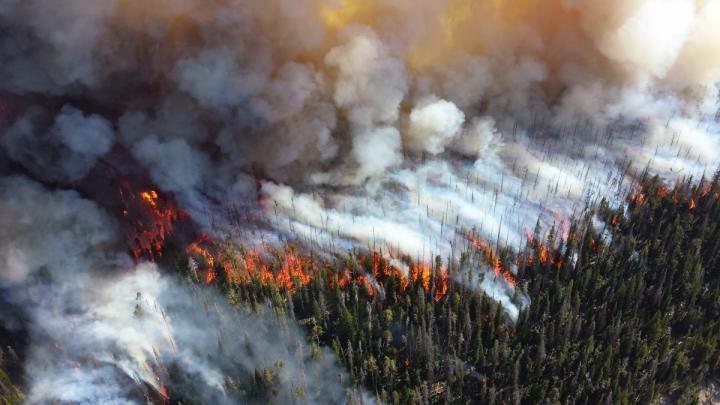Novel 3D computational study links observable forest characteristics with fire behavior and reveals how forest structure propagates fire

Credit: Courtesy of National Park Service
LOS ALAMOS, N.M., January 27, 2021–A new 3D analysis shows that wildland fires flare up in forests populated by similar-sized trees or checkerboarded by large clearings and slow down where trees are more varied. The research can help fire managers better understand the physics and dynamics of fire to improve fire-behavior forecasts.
“We knew fuel arrangement affected fire but we didn’t know how,” said Adam Atchley, lead author on a Los Alamos National Laboratory-led study published today in the International Journal of Wildland Fire. “Traditional models that represent simplified fuel structures can’t account for complex wind and varied fire response to actual forest conditions. Our study incorporated a varied, 3D forest and wind behavior. Adding diverse tree sizes and shapes slowed fire quite a bit, as did adding small gaps between trees. By examining the physics of fire-fuel behavior, we are able to see fundamentally how forest structure affects behavior.”
The study for the first time links generalized forest characteristics that can be easily observed by remote sensing and modeled by machine learning to provide insight into fire behavior, even in large forested areas.
Understanding how wildland fire behaves is necessary to curb its spread, and also to plan safe, effective prescribed burns. However, data is limited, and most studies are too simplistic to accurately predict fire behavior. To predict how fire will move through a forest, it is necessary to first paint an accurate picture of a typical forest’s diversity with varying density, shapes, and sizes of trees. But this is computationally expensive, so most studies target homogenous forests that rarely occur in nature.
Using its award-winning model, FIRETEC, on high-performance computers at Los Alamos, the team ran 101 simulations with U.S. Forest Service data for Arizona pine forests to realistically represent the variability of forests. The simulations coupled fire and atmospheric factors–such as wind moving through trees–at fine scales to provide a 3D view of how fire, wind, and vegetation interact.
To understand how the forest structure affects fire behavior, Atchley and colleagues repeated simulations with minor changes in the forest structure, which they made by moving trees and randomizing tree shapes. Small changes had monumental impact in fire behavior. However, despite highly variable fire behavior, observable forest characteristics, such as tree diversity and the size of a stand of trees or a clearing, also substantially control how fire spreads.
Results show that the more detailed and varied simulated forest decreases the forward spread of fire spread due to a combination of fuel discontinuities and increases fine-scale turbulent wind structures. On the other hand, large clearings can increase fire spread.
###
Funding: This work was supported by USDA Forest Service Research National Fire Plan through Interagency Agreements. The Los Alamos National Laboratory Institutional Computing program provided computational resources and Laboratory Directed Research and Development program provided model development support.
The paper: “Effects of fuel spatial distribution in wildland fire behavior,” Adam L. Atchley, Rodman Linn, Alex Jonko, Chad Hoffman, Jeffrey D. Hyman, Francois Pimont, Carolyn Sieg, and Richard S. Middleton, International Journal of Wildland Fire, https:/
About Los Alamos National Laboratory
Los Alamos National Laboratory, a multidisciplinary research institution engaged in strategic science on behalf of national security, is managed by Triad, a public service oriented, national security science organization equally owned by its three founding members: Battelle Memorial Institute (Battelle), the Texas A&M University System (TAMUS), and the Regents of the University of California (UC) for the Department of Energy’s National Nuclear Security Administration.
Los Alamos enhances national security by ensuring the safety and reliability of the U.S. nuclear stockpile, developing technologies to reduce threats from weapons of mass destruction, and solving problems related to energy, environment, infrastructure, health, and global security concerns.
LA-UR-21-20436 Version 3
Media Contact
Charles Poling
[email protected]
Original Source
https:/
Related Journal Article
http://dx.




